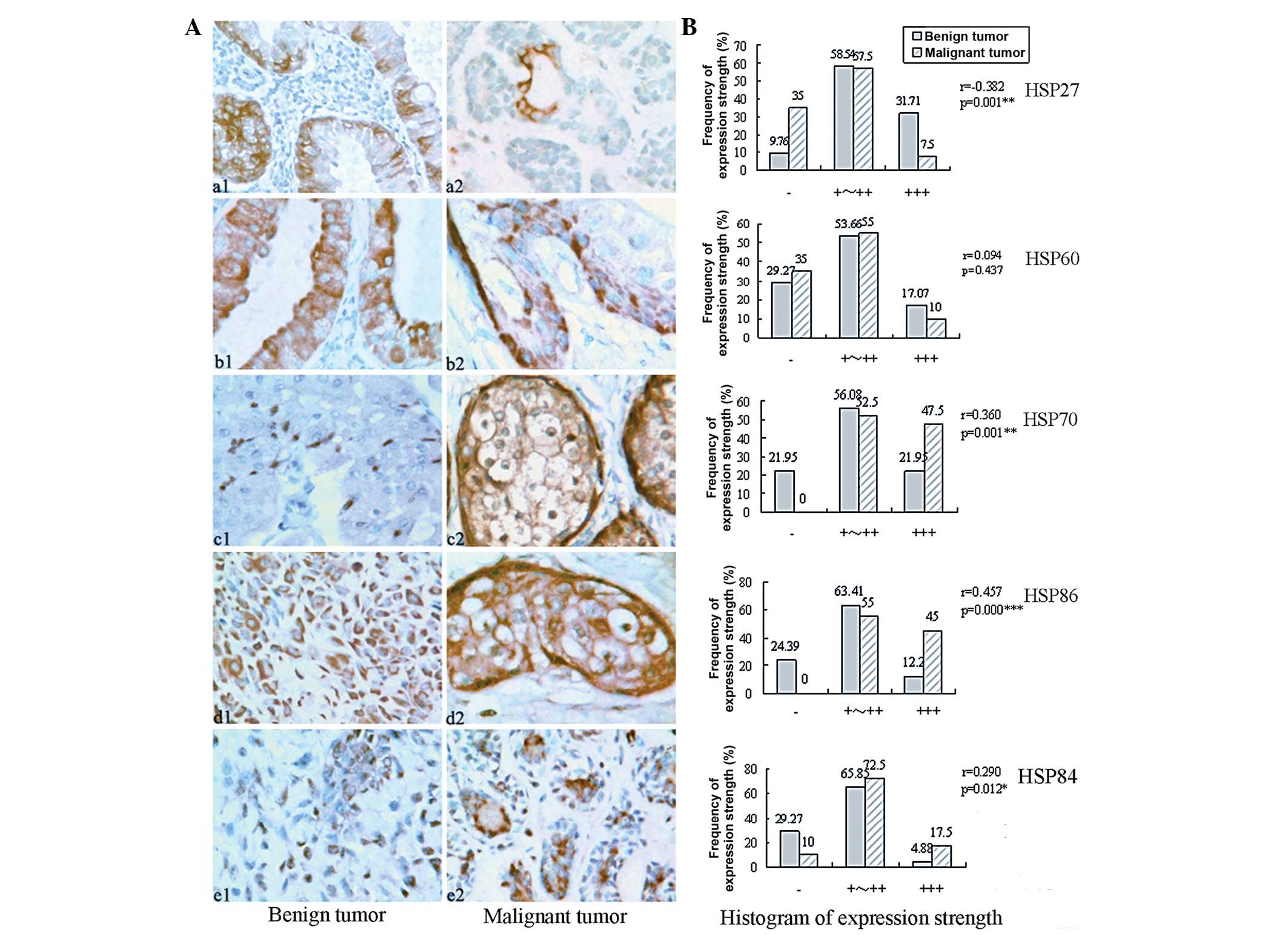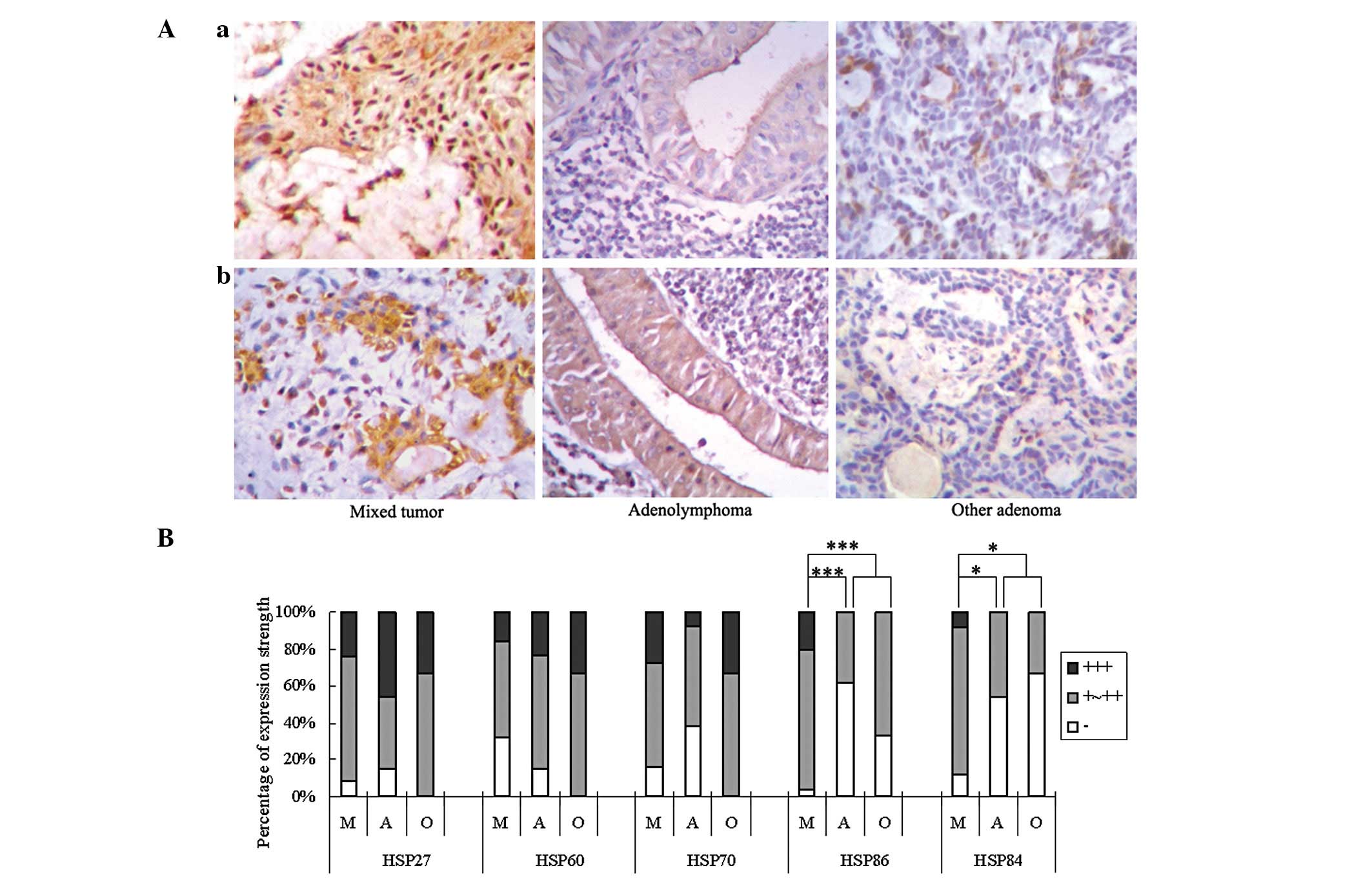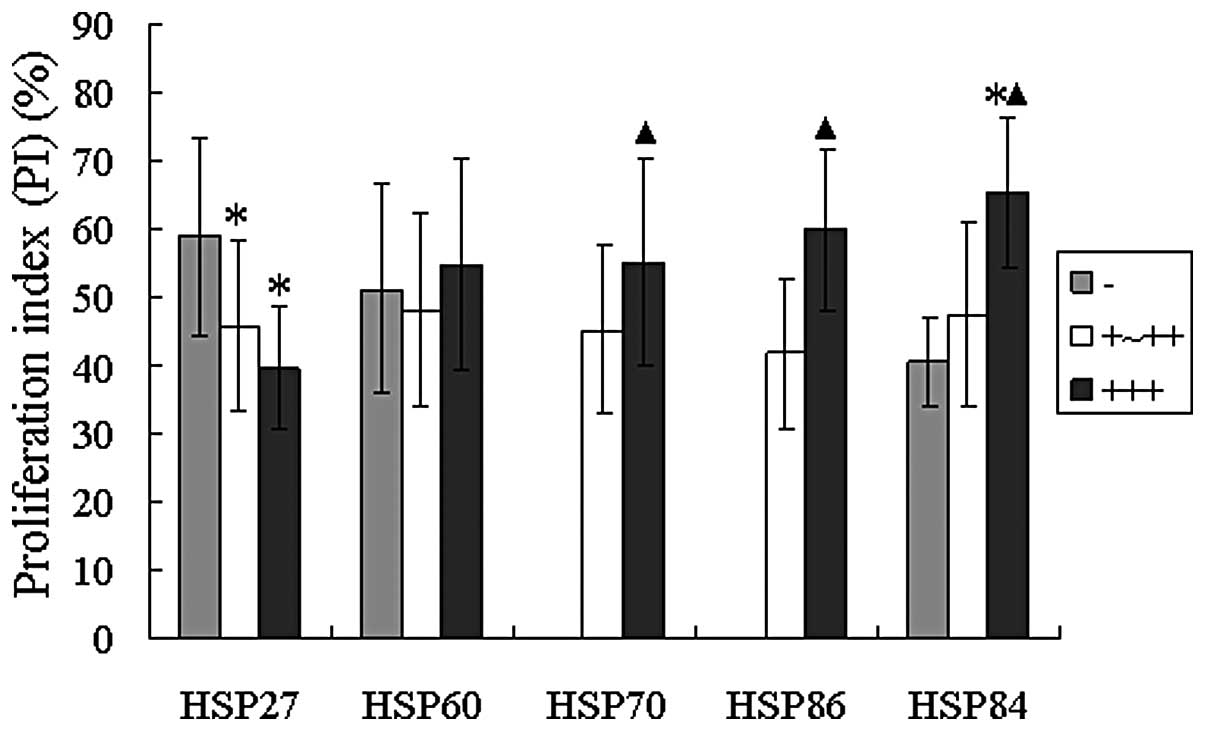|
1
|
Khalil AA, Kabapy NF, Deraz SF and Smith
C: Heat shock proteins in oncology: diagnostic biomarkers or
therapeutic targets? Biochim Biophys Acta. 1816:89–104.
2011.PubMed/NCBI
|
|
2
|
Scroggins BT, Robzyk K, Wang D, et al: An
acetylation site in the middle domain of Hsp90 regulates chaperone
function. Mol Cell. 25:151–159. 2007. View Article : Google Scholar : PubMed/NCBI
|
|
3
|
Kim LS and Kim JH: Heat shock protein as
molecular targets for breast cancer therapeutics. J Breast Cancer.
14:167–174. 2011. View Article : Google Scholar : PubMed/NCBI
|
|
4
|
Park SJ, Kostic M and Dyson HJ: Dynamic
interaction of Hsp90 with its client protein p53. J Mol Biol.
411:158–173. 2011. View Article : Google Scholar : PubMed/NCBI
|
|
5
|
Rérole AL, Gobbo J, De TA, et al: Peptides
and aptamers targeting HSP70: a novel approach for anticancer
chemotherapy. Cancer Res. 71:484–495. 2011.
|
|
6
|
Guo QY, Yuan M, Peng J, Cui XM, Song G,
Sui X and Lu SB: Antitumor activity of mixed heat shock
protein/peptide vaccine and cyclophosphamide plus interleukin-12 in
mice sarcoma. J Exp Clin Cancer Res. 30:242011. View Article : Google Scholar : PubMed/NCBI
|
|
7
|
Okui T, Shimo T, Hassan NM, et al:
Antitumor effect of novel HSP90 inhibitor NVP-AUY922 against oral
squamous cell carcinoma. Anticancer Res. 31:1197–1204.
2011.PubMed/NCBI
|
|
8
|
Barnes L, Eveson JW, Reichart P and
Sidransky D: World Health Organization Classification of Tumours.
Pathology and Genetics of Head and Neck Tumours. IARC Press; Lyon:
pp. 209–281. 2005
|
|
9
|
Gibert B, Hadchity E, Czekalla A, et al:
Inhibition of heat shock protein 27 (HspB1) tumorigenic functions
by peptide aptamers. Oncogene. 30:3672–3681. 2011. View Article : Google Scholar : PubMed/NCBI
|
|
10
|
Banerjee S, Lin CF, Skinner KA, et al:
Heat shock protein 27 differentiates tolerogenic macrophages that
may support human breast cancer progression. Cancer Res.
71:318–327. 2011. View Article : Google Scholar
|
|
11
|
Kwon SM, Kim SA, Fujii S, Maeda H, Ahn SG
and Yoon JH: Transforming growth factor β1 promotes migration of
human periodontal ligament cells through heat shock protein 27
phosphorylation. Biol Pharm Bull. 34:486–489. 2011.
|
|
12
|
Shen G, Liang S, Xu Z, et al:
Dowuregulated expression of HSP27 in human low-grade glioma tissues
discovered by a quautitative proteomic analysis. Proteomic Sci.
26:17–28. 2010. View Article : Google Scholar : PubMed/NCBI
|
|
13
|
Quintana FJ and Cohen IR: The HSP60 immune
system network. Trends Immunol. 32:89–95. 2011. View Article : Google Scholar : PubMed/NCBI
|
|
14
|
Cappello F, de Macario EC, Zummo G and
Macario AJ: Immunohistochemistry of human Hsp60 in health and
disease: from autoimmunity to cancer. Methods Mol Biol.
787:245–254. 2011. View Article : Google Scholar : PubMed/NCBI
|
|
15
|
Xu X, Wang W, Shao W, et al: Heat shock
protein-60 expression was significantly correlated with the
prognosis of lung adenocarcinoma. J Surg Oncol. 104:598–603. 2011.
View Article : Google Scholar : PubMed/NCBI
|
|
16
|
Kayama M, Nakazawa T, Thanos A, et al:
Heat shock protein 70 (HSP70) is critical for the photoreceptor
stress response after retinal detachment via modulating
anti-apoptotic Akt kinase. Am J Pathol. 178:1080–1091. 2011.
View Article : Google Scholar : PubMed/NCBI
|
|
17
|
Zhang J, Wang K, Zhang J, Liu SS, Dai L
and Zhang JY: Using proteomic approach to identify tumor-associated
proteins as biomarkers in human esophageal squamous cell carcinoma.
J Proteome Res. 10:2863–2872. 2011. View Article : Google Scholar : PubMed/NCBI
|
|
18
|
Kocsis J, Mészáros T, Madaras B, et al:
High levels of acute phase proteins and soluble 70 kDa heat shock
proteins are independent and additive risk factors for mortality in
colorectal cancer. Cell Stress Chaperones. 16:49–55. 2011.
View Article : Google Scholar : PubMed/NCBI
|
|
19
|
Zhu Q, Xu YM, Wang LF, et al: Heat shock
protein 70 silencing enhances apoptosis inducing factor-mediated
cell death in hepatocellular carcinoma HepG2 cells. Cancer Biol
Ther. 8:792–798. 2009. View Article : Google Scholar : PubMed/NCBI
|
|
20
|
Beck R, Dejeans N, Glorieux C, et al:
Molecular chaperone Hsp90 as a target for oxidant-based anticancer
therapies. Curr Med Chem. 18:2816–2825. 2011. View Article : Google Scholar : PubMed/NCBI
|
|
21
|
Taiyab A and Rao ChM: HSP90 modulates
actin dynamics: inhibition of HSP90 leads to decreased cell
motility and impairs invasion. Biochim Biophys Acta. 1813:213–221.
2011. View Article : Google Scholar : PubMed/NCBI
|
|
22
|
Kubota H, Yamamoto S, Itoh E, et al:
Increased expression of co-chaperone HOP with HSP90 and HSC70 and
complex formation in human colonic carcinoma. Cell Stress
Chaperones. 15:1003–1011. 2010. View Article : Google Scholar : PubMed/NCBI
|
|
23
|
Walsh N, Larkin A, Swan N, Conlon K,
Dowling P, McDermott R and Clynes M: RNAi knockdown of Hop
(Hsp70/Hsp90 organising protein) decreases invasion via MMP-2 down
regulation. Cancer Lett. 306:180–189. 2011. View Article : Google Scholar : PubMed/NCBI
|
|
24
|
Abike F, Tapisiz OL, Zergeroglu S, Dunder
I, Temizkan O and Payasli A: PCNA and Ki-67 in endometrial
hyperplasias and evaluation of the potential of malignancy. Eur J
Gynaecol Oncol. 32:77–80. 2011.PubMed/NCBI
|
|
25
|
Kato K, Kawashiri S, Yoshizawa K, et al:
Expression form of p53 and PCNA at the invasive front in oral
squamous cell carcinoma: correlation with clinicopathological
features and prognosis. J Oral Pathol Med. 40:693–698. 2011.
View Article : Google Scholar : PubMed/NCBI
|
|
26
|
Salinthone S, Ba M, Hanson L, Martin JL,
Halayko AJ and Gerthoffer WT: Overexpression of human Hsp27
inhibits serum-induced proliferation in airway smooth muscle
myocytes and confers resistance to hydrogen peroxide cytotoxicity.
Am J Physiol Lung Cell Mol Physiol. 293:1194–1207. 2007. View Article : Google Scholar
|


















